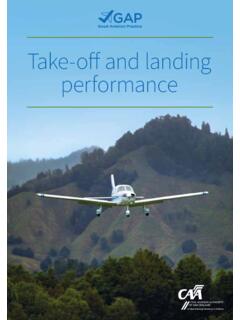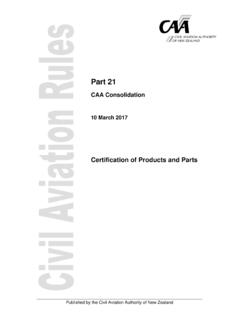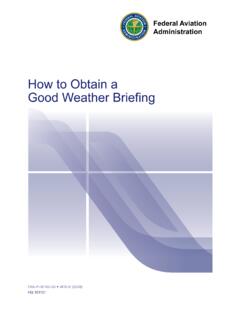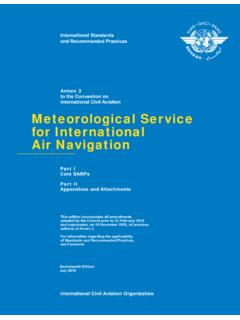Transcription of New Zealand airspace - CAA and Avsec | aviation.govt.nz
1 Includes drone adviceNew Zealand airspaceContentsAbbreviations ..3 Introduction ..4 AIP New Zealand ..4 Visual aeronautical charts ..4 Designated airspace ..6 Controlled aerodrome ..6 Controlled airspace ..6 airspace classification ..8 Transponder mandatory airspace ..10 VFR transit lanes ..10 General aviation zones ..13 Special use airspace ..14 Restricted area ..15 Military operating area (MOA) ..16 Danger area ..17 Volcanic hazard zone (VHZ) ..17 Mandatory broadcast zone (MBZ) ..18 Low flying zone (LFZ) ..19UA (drones and model aircraft) ..20 Consider others, be responsible ..21 Know the no-fly zones ..21 Preflight checklist ..22 Training ..22 More information about flying your drone ..22 Useful resources ..23 Non-designated airspace ..24 Common frequency zone (CFZ) ..24 Parachute landing area (PLA).
2 24 Air traffic services ..26 Air traffic control units ..27 Aerodrome and area flight information services ..28 Assistance ..29 Conclusion ..30 airspace poster ..30 Radio phraseology ..30 Useful websites ..30 Every effort is made to ensure that the information in this booklet is accurate and up to date at the time of publishing, but numerous changes can occur with time, especially in regard to airspace and legislation. Readers are reminded to obtain appropriate up to date the CAA website for Civil Aviation Rules, advisory circulars, airworthiness directives, forms, and more safety publications. Visit : ACASA irborne collision avoidance systemAFISA erodrome flight information serviceAGLA bove ground levelAIPNZA eronautical Information Publication New ZealandAMSLA bove mean sea levelATCAir traffic controlATSAir traffic servicesCAAC ivil Aviation Authority (of New Zealand )CFZC ommon frequency zoneCTAC ontrol areaCTRC ontrol zoneDMED istance measuring equipmentFIRF light information regionFISF light information serviceFLFlight level (hundreds of feet)GAAG eneral aviation areaGAPGood Aviation Practice (booklet)GPSG lobal positioning systemH24 Hours.
3 24 (ie, permanent)ICAOI nternational Civil Aviation OrganizationIFRI nstrument flight rulesLFZLow flying zoneMBZM andatory broadcast zoneMOAM ilitary operating areaNORDONon radio equippedNOTAMN otice to AirmenOCAO ceanic control areaPLAP arachute landing areaPSRP rimary surveillance radarQNHA ltimeter sub scale settingRNZAFR oyal New Zealand Air ForceRPASR emotely piloted aircraft systemsSIGMETI nformation concerning the occurrence or expected occurrence of hazardous weather conditions in a given airspaceSSRS econdary surveillance radarSVFRS pecial visual flight rulesTMTransponder mandatory airspaceUAUnmanned aircraftUNICOMU niversal communication serviceVFRV isual flight rulesVHZV olcanic hazard zoneVMCV isual meteorological conditionsVNCV isual navigation chartVPCV isual planning chart3 New
4 Zealand airspaceIntroductionControlled airspace and special use airspace are prescribed by the Civil Aviation Authority (CAA). Where the Director of Civil Aviation has determined that a portion of airspace requires an air traffic control service, it is designated as controlled airspace to protect IFR routes and procedures. Special use airspace can also be designated for a number of purposes. These may include facilitation of police operations, search and rescue operations, military activities, environmental and conservation purposes, and for major public you can imagine, airspace design is a complex undertaking that encompasses a AIP New Zealandwide array of international standards and procedures. These include safe approach and departure routes at major airports, while also enabling efficient en route air navigation.
5 The airspace must cater for a variety of aircraft performances, while also accounting for New Zealand s rugged, and sometimes restrictive, keep our skies safe, it s essential that all pilots, drone users included, have a sound knowledge of airspace , and that they are able to use aeronautical charts and airspace information Aeronautical Information Publication New Zealand (AIP) is a collective name given to a number of publications relating to airspace and documents define the regulatory and airspace requirements to fly in New AIP includes: AIP New Zealand Vols 1 to 4 (available online, ) AIP Supplements Air Navigation Register Visual navigation and planning charts En route charts (for IFR).NOTAMs (stands for Notices to Airmen) are notices issued about any change to airspace , aerodromes, or hazards, that require immediate AIP is published for the CAA by Aeropath via the website , under a Part 175 aeronautical chartsFor visual navigation, use the visual planning charts (VPCs) and the visual navigation charts (VNCs).
6 Details of the current visual chart series are in AIP New Zealand , The table shows the scales of charts available, and their colour must carry and use the most up to date visual charts if they are operating VFR, or are IFR and conducting visual purchase visual charts, see or tel: 0800 500 :1 000 000A1 and A2 VPCs to be used for planning purposes and for flight above 10,000 ftB1:500 000B1 to B6 VNCs covering the whole country, and most suited for cross country navigation (less airspace information than the 1:250 000 scale).C1:250 000C1 to C14 VNCs covering the whole country, and most suited to low level and local :125 000D1 and D2 D1 Auckland Terminal, and D2 Christchurch Terminal, VNCs depicting a larger scale of the Auckland and Christchurch Zealand airspaceDesignated airspacearea of responsibility is designated with that State s code, such as NS for Samoa.
7 Following the letters are three numbers: the first signifies the briefing area the airspace is generally within, and the other two the airspace number. For example: NZL663 is a low flying zone (LFZ) in Briefing Area 6. (The airspace designator is restricted to three digits, so in Briefing Area 10 the first number used is 7.)Controlled aerodromeA controlled aerodrome is an aerodrome with an aerodrome control service provided by Airways (New Zealand s air traffic service provider). A controlled aerodrome does not necessarily mean that controlled airspace also learn more about the types of air traffic service provided, see page airspaceControlled airspace is sometimes described as an upside down wedding cake , (see diagram). There are two types of controlled airspace : control zones (CTRs) the bottom tier of the cake touching the surface of the earth and control areas (CTAs) the upper tiers.
8 Controlled airspace is established to protect the flight paths and procedures of IFR aircraft (usually commercial flights).Within controlled airspace , air traffic control (ATC) provides wake turbulence separation. For more on wake turbulence, see the CAA GAP Booklet Wake airspace is described by the CAA in the Air Navigation Register, a part of AIP New Zealand . The Air Navigation Register can be accessed free of charge on the AIP New Zealand website, The Register contains the geographic coordinates of various temporary and permanent designated airspace has a unique alphanumeric designator, as well as a name. All New Zealand airspace designators start with NZ followed by a letter indicating the type of airspace . airspace used by other Pacific States within New Zealand s New Zealand Briefing AreasAIP New Zealand Figure GEN Zealand FIR (NZZC)AUCKLAND OCEANIC FIR (NZZO)6 Control zonesControl zones (CTRs) protect arriving and departing IFR flights and are the only type of controlled airspace that touch the surface of the a CTR, sectors designed to facilitate air traffic management may be established.
9 CTR sectors are depicted on C Series visual navigation charts, but not all CTRs have sectors. VFR aircraft may be given joining or departure instructions via one of these sectors. ATC can also instruct IFR aircraft on a visual approach or departure to use a sector. At some CTRs there are published arrival and departure routes for VFR and IFR aircraft. For the VFR pilot, this information is found in AIP New Zealand , Vol 4 AD section, Aerodrome areasControl areas (CTAs) extend from a specified lower limit to a specified upper limit. Examples of CTAs include: CTAs that are established around one or more aerodromes and are designed to encompass the flight paths of controlled flights on instrument approaches or departures, and also encompass IFR en route operations. Oceanic control areas (OCAs) that are normally established over the high seas.
10 Pilots should be aware that not all instrument holding and arrival/departure tracks are contained within CTAs. Holding procedures and DME arcs normally provide a 1000 foot minimum terrain and obstacle clearance, but they do not always ensure that the flight is contained within controlled with CTRs, sectors may also be established within CTAs to aid air traffic zone (CTR)Control area (CTA)VFR transit laneGeneral aviation area (GAA)7 New Zealand airspaceAirspace classificationIn New Zealand , airspace is classified under the International Civil Aviation Organization (ICAO) airspace classification system. This system determines the level of air traffic service (ATS) that will be provided, and whether entry to that airspace requires an ATC level of service cannot be varied by ATC for any given class of following table shows the ICAO classes of airspace that are used in New Zealand , along with their operating are seven ICAO classes of airspace , ranging from class A through to class G.












